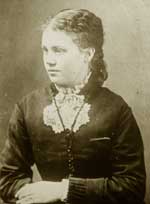|
School Years 1851-54 |
" (The Kaw
Mission School) averaged about thirty pupils, all boys.
The branches taught were spelling, reading, writing, and
arithmetic. None of them received instruction in the
trades. The boys worked well on the farm."
–Teacher Thomas Huffaker, 1905
|
The Treaty of 1846 had
provided that the government would make an annual
payment of one thousand dollars to advance the education
of the Kaws in their own country. In September 1850,
the Methodist Episcopal Church South entered into a
contract with the U.S. government, and construction of
the mission was completed by February of 1851.
|
 |
School
began in May 1851, under the direction of Thomas Sears
Huffaker, a 25-year-old teacher who had served in the
same capacity at the Shawnee Manual Labor School near
present Kansas City. At the most, thirty Kaw boys
lived upstairs in four rooms. There were two classrooms
downstairs on the west side and two rooms which served
as living quarters for the staff on the east side. |
|
Classes
were held for the Kaw boys until 1854, when the school
was closed because of the excessive cost–fifty dollars
a year–of maintaining each student. The Kaws never
responded favorably to the efforts of the church and
sent to the school only boys described as "orphans
and dependents of the tribe." Many members of the
tribe considered the ways of white people degrading.
Also, the teaching methods and cultural assumptions of
the school administrators and teachers probably impeded
effective cross-cultural instruction.
|
The
white perspective on the operation of the Kaw Mission is
best captured in a quarterly report penned by Shawnee
Mission superintendent Thomas Johnson, who was Huffaker’s
supervisor. Writing to the Office of Indian Affairs on
January 21, 1852, Johnson expresses his frustration with
the Kaws:
|
|
"You
will perceive from the accounts that the number of
scholars was only fifteen. The number might have been
much larger but at the commencement of the quarter
everyone of the mission family was sick & they could
not take a large number & many of the Indian
children were sick also, & their relations insisted
on taking them with them on their Buffalo hunt.
But I
hope in future we may be able to do better; though I am
compelled to acknowledge that the prospect is not very
encouraging. For this entire tribe of Indians are so
much in the habit of stealing from every body in their
reach, I am at a loss to determine how we can support a
large school among them."
|
Other
factors may have compounded the difficulties at the Kaw
Mission. Huffaker, who initially had not mastered the Kaw
language, relied on a mixed-blood interpreter to
communicate with his students. A year after he came to
the Mission, Huffaker married the sixteen-year-old Eliza
Baker, daughter of the Kaw Mission housekeeper.
|
 |
A year
later the first of their eleven children, Suzie, was
born in the Kaw Mission. Considering the diverse
individuals assembled under the Kaw Mission roof,
chances for a successful mission operation were hardly
auspicious: a young teacher and his teen-age wife, both
not adept in the Kaw language, Huffaker’s
mother-in-law, a baby, and a dozen or more Kaw boys
abruptly uprooted from their tepee villages.
|
|
In 1855, a
Kaw agent pronounced a final gloomy assessment of the
Kaw Mission effort: "at present (the Kaws) have
no school, and it seems that what they have had has been
only a dead expense to the government; those who have
enjoyed the privilege of the school heretofore are now
no more than common Kaws in dress, manners, and
everything else."
|
|
|


